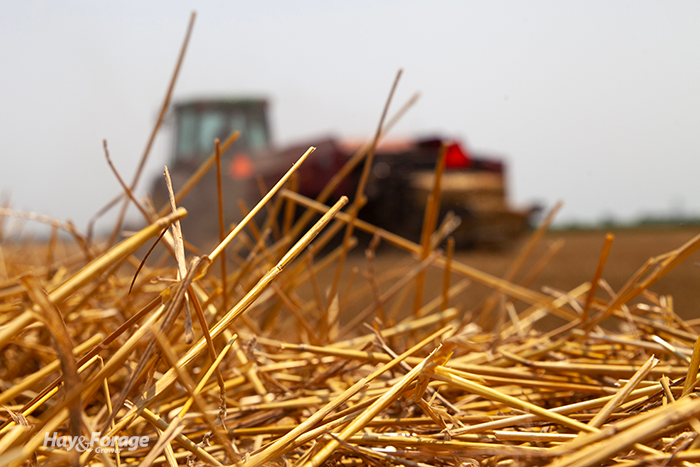
Adding a farm enterprise is often a complicated and hand-wringing exercise in decision making. But every once in a while, the stars align and an additional enterprise just makes perfect sense with little nail biting involved.
That latter scenario seems to fit commercial haymakers who happen to hang their hat in an area where wheat is grown for grain. In such situations, there are usually acres of straw just waiting to be purchased in the windrow from farms where balers are banned from the machine shed.
Whereas high-quality hay may always be the primary enterprise, I have rarely visited a commercial hay farm in wheat country that didn’t tap into the opportunity to bale the golden straw that forms stripes across the rural landscape during mid-summer.
Baling wheat straw requires all of the same equipment and mindset needed for hay, sans the anxiety caused by maturity concerns, rain events, and slow dry down. Often, there’s no need for windrow manipulation, either. Baling good, clean straw is that mid-summer mental break that every haymaker needs. It also doesn’t hurt that you can add significantly to the bottom line while doing so.
Many wheat growers are eager to sell their windrowed straw to a willing baler, either because it makes for extra income or they just want to eliminate the plant residue in their fields.
The straw market has widened substantially from what it used to be 25 years ago. These days, there remains the bedding and mulch markets, although straw is used for cow bedding much less frequently than it used to be. Making up for that reduction is the feed straw market for dairy total mixed rations. Some dairies use straw in their milking cow rations to add physical fiber. Many more dairies use significant amounts of straw in their dry cow rations. It’s this feed market that has pushed the value of straw northward, adding income for both the wheat grower and straw baler/marketer.
Nutrient value varies
During my extension agent years, I was often asked about the nutrient value of straw by wheat growers who wanted to sell their straw off the field. The thinking was that they wanted to receive — at minimum — the fertilizer value for the straw they sold off the field.
Many state university agronomists have gone to the trouble of analyzing straw for its nutrient value. When looking at published data, you’ll find some variability in nutrient content from state to state. Below are the ranges:
Nitrogen: 11 to 15 pounds per ton
Phosphorus (as P2O5): 3 to 6 pounds per ton
Potassium (as K2O): 15 to 29 pounds per ton
Most of the variation in state-to-state nutrient levels is due to the inherent differences of soils and management practices that prevail in various regions. For example, nitrogen fertilization can impact the plant’s nitrogen content, and the height of straw stubble also will affect the nutrient concentrations of the harvested straw.
In states where a lot of manure gets spread on fields, soil phosphorus levels tend to build, and on some farms, soil potassium levels are kept high for producing alfalfa. It’s often in these states where straw nutrient values are on the upper end of the range.
During the past year, fertilizer costs have come down from the historic highs of a couple of years ago, making straw less valuable as a fertilizer replacement. In most cases, straw is going to be worth about $20 per ton on a fertilizer replacement value basis that includes all three major nutrients. Nitrogen accounts for a little over $7 of wheat’s total value, but it’s always debatable if it should be included.
If left unbaled in the field, the nitrogen in wheat straw will not be immediately available to plants. It will first have to be mineralized by microorganisms and converted to ammonium and nitrate. In fact, leaving the residue on the field will tie up additional nitrogen in the short term as the mineralization process takes place. Wheat straw has an extremely high carbon-to-nitrogen ratio (80:1), so the whole process takes time.
Wheat residue is a good source of carbon that will ultimately contribute to a soil’s organic matter content. This is difficult to put a dollar value on, but it is a consideration if wheat is grown repeatedly on a particular field and the residue is removed. The occasional removal of straw (for example, once in a rotation) will likely have very little impact on the soil’s long-term organic matter content.
Wet weather woes
Having windrowed straw rained on doesn’t elicit quite the consternation that rained on hay does, but it still causes chemical and visual changes. Unfortunately, frequent rains have been a problem this year in many wheat-growing regions where straw is routinely baled.
Visually, rain results in straw losing its “golden” color. Chemically, rain can leach some of the nutrients from the product, especially potassium. For many end users, neither of these changes is going to make much of a difference as long as the straw is dry. If frequent rains occur before the straw is baled, molds and/or mycotoxins become a potential problem.
Weedy straw often takes longer to dry. Green weeds that are put into the bale can be cause for bale heating and mold, which could create health issues if the straw is being used for horse bedding. It also will make for a much more unpleasant and dirtier task if the straw is ultimately chopped for feed or bedding.
Depending on regional availability and local livestock usage, straw is a natural and profitable additional enterprise for haymakers. In some areas, it’s not uncommon to see retail prices approaching that of average to good quality hay. There is also additional income to be made for the wheat grower who has no use for the straw beyond soil nutrient value.

